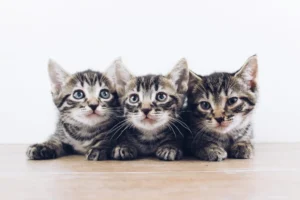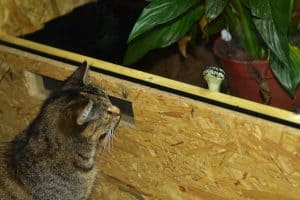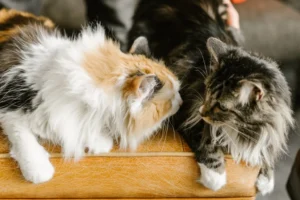Cats and rabbits share striking similarities in their behaviors and physical appearances that often leave people wondering why. The truth is, these two fluffy creatures have more in common than meets the eye.
Cats and Rabbits: Exploring Their Intriguing Similarities
Evolutionary Background:
Cats and rabbits may seem like unlikely companions, but their similarities can be traced back to a common ancestor. Both belong to the order Carnivora, which encompasses carnivorous mammals like cats, as well as lagomorphs such as rabbits. This shared evolutionary history explains some of the physical and behavioral similarities between these seemingly different animals.
While cats have evolved to become efficient predators with sharp teeth and claws, rabbits have adapted to be agile prey animals with strong hind legs for quick escapes. Despite these differences in survival strategies, both cats and rabbits share a common lineage that has influenced their genetic makeup and development over time.
Predatory Instincts:
When it comes to predatory instincts, both cats and rabbits exhibit behaviors rooted in their evolutionary past. While cats are known for their hunting prowess, stalking their prey before pouncing with precision, rabbits have evolved to be hyperaware of potential predators, always on the lookout for danger.
Interestingly, both cats and rabbits have a strong drive to hunt, albeit for different reasons. While cats hunt for sustenance, rabbits hunt to avoid becoming prey themselves. This shared instinct for survival has shaped their behaviors and instincts, making them more similar than one might initially think.
Key insight: One interesting similarity in their predatory instincts is their acute sense of hearing, allowing both cats and rabbits to detect even the slightest sound of potential danger. This shared trait highlights how their evolutionary histories have shaped their survival mechanisms in similar ways.
By understanding the evolutionary background and predatory instincts of cats and rabbits, we can appreciate the unique similarities that exist between these two seemingly different animals. Despite their differences in appearance and behavior, both cats and rabbits share a common thread that connects them through their shared genetic heritage.
Communication Styles:
Cats and rabbits share a similar communication style, using body language and vocalizations to express their needs and emotions. Both animals use their ears, tail movements, and vocal sounds to communicate with each other and their human companions. For example, a cat’s purring often signals contentment, while a rabbit’s thumping indicates fear or agitation. Understanding these communication cues can help pet owners better care for their furry friends and build stronger bonds with them.
Dietary Habits:
When it comes to dietary habits, cats and rabbits may seem different, but they share a common need for a balanced diet rich in protein. Both animals are obligate carnivores, meaning they require meat for essential nutrients. While cats primarily eat meat, rabbits need a mix of hay, fresh vegetables, and a small amount of pellets to stay healthy. Providing a proper diet for both cats and rabbits is crucial for their overall well-being and longevity.
One unique insight to consider is that while cats are known for their independence and hunting skills, rabbits are social animals that thrive in pairs or groups. This difference in social behavior can impact their dietary habits, as rabbits may benefit from companionship to reduce stress and feel more secure while eating. This insight highlights the importance of considering not only the nutritional needs of cats and rabbits but also their social and emotional well-being when caring for these beloved pets.
Grooming Rituals:
Cats and rabbits share a common bond in their meticulous grooming rituals. Both animals devote a significant amount of time to grooming themselves, ensuring their fur stays clean and well-maintained. Cats use their rough tongues to lick their fur clean, while rabbits meticulously groom themselves with their paws and teeth. This behavior not only helps them stay clean but also allows them to regulate their body temperature and remove any parasites or debris from their fur.
Interestingly, grooming is not just a solo activity for these animals; it also serves as a social bonding experience. Cats often groom each other as a sign of affection and to strengthen social bonds within their group. Rabbits, on the other hand, engage in mutual grooming to establish hierarchy and social order within their warren. This shared grooming behavior highlights the similarities in the importance of grooming for both cats and rabbits, not just for hygiene but also for social interactions and group dynamics.
Social Structure:
In the world of felines and lagomorphs, social structure plays a crucial role in determining hierarchy and relationships within the community. Cats, especially those in feral colonies, establish a clear dominance hierarchy where each cat knows its place based on age, size, and personality. They form alliances and work together to maintain their territory and protect themselves from perceived threats, displaying a complex social structure similar to that of rabbits.
Rabbits, on the other hand, have a hierarchical social structure based on dominance and subordination. Within a warren, dominant rabbits assert their authority through aggressive behavior and territorial displays, while subordinate rabbits comply with social cues to maintain peace within the group. This social order helps rabbits coordinate activities such as foraging and keeping watch for predators, showcasing a structured way of living similar to that of cats.
Additional Unique Insight:
When it comes to social interactions, cats are often seen as more independent animals compared to rabbits, who thrive in communal living arrangements. Despite this difference in social behavior, both cats and rabbits exhibit intricate social structures that revolve around hierarchy, alliances, and mutual grooming. This unique insight sheds light on the diverse ways in which these seemingly different animals navigate their social worlds while still sharing common traits and behaviors.
Playful Nature:
Cats and rabbits share a playful nature that often surprises and delights their human companions. Both species have a natural curiosity and love for exploration, making them experts at turning ordinary objects into toys. From crinkly paper balls to cardboard boxes, cats and rabbits can transform any item into hours of entertainment. Their playful antics not only provide mental stimulation but also help them stay active and maintain a healthy weight. Interaction with toys and games is essential for their overall well-being, so be sure to provide plenty of enrichment opportunities for your furry friends.
Health and Welfare:
Proper care and regular veterinary attention are crucial for maintaining the health and welfare of both cats and rabbits. Just like humans, these animals require regular check-ups to ensure they are in good health and to address any potential issues before they become serious. It’s important to provide a balanced diet, regular exercise, and a safe living environment for your pets. Additionally, spaying or neutering your cat or rabbit can help prevent certain health issues and unwanted behaviors. Remember, a happy and healthy pet is a loved pet, so prioritize their well-being with proper care and attention.
- Unique Insight: Did you know both cats and rabbits are obligate nasal breathers? This means that they primarily breathe through their noses rather than their mouths, which is why any respiratory issues should be taken seriously and addressed promptly.
Remember, by understanding and meeting the needs of your cats and rabbits, you can ensure they lead fulfilling and healthy lives.
Fun Facts:
- Cats and rabbits actually share a common ancestor, making them more similar than meets the eye.
- Rabbits and cats have a similar digestive system, with both being obligate carnivores.
- Both cats and rabbits are crepuscular animals, meaning they are most active during dawn and dusk.
- Did you know that cats and rabbits groom themselves in a similar manner, using their tongues to clean their fur?
- Unlike dogs, both cats and rabbits have the ability to purr as a form of communication and contentment.
Ready for a unique insight? Here you go: Interestingly, both cats and rabbits have a unique reflective layer behind their retinas called the tapetum lucidum, allowing them to see in low light conditions. This shared trait enhances their ability to hunt or stay vigilant during the night.
Alex, a passionate animal lover, has experience in training and understanding animal behavior. As a proud pet parent to two dogs and three cats, he founded AnimalReport.net to share insights from animal experts and expand his knowledge of the animal kingdom.









